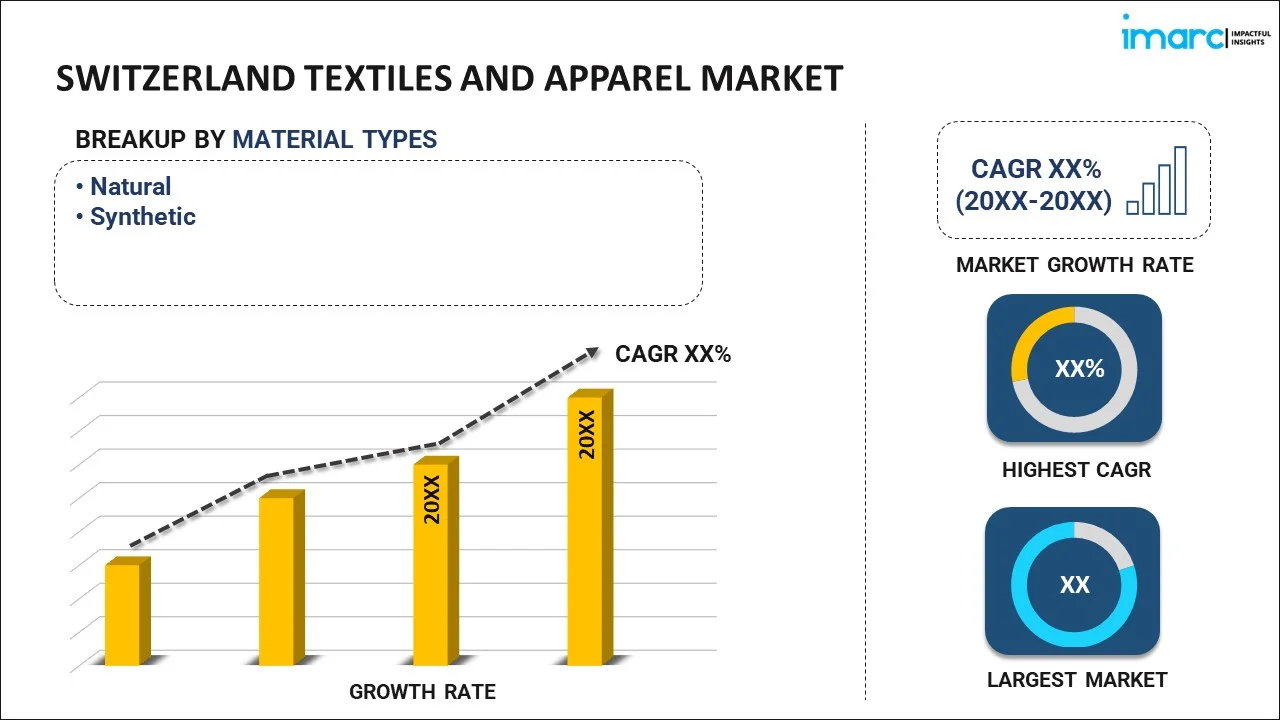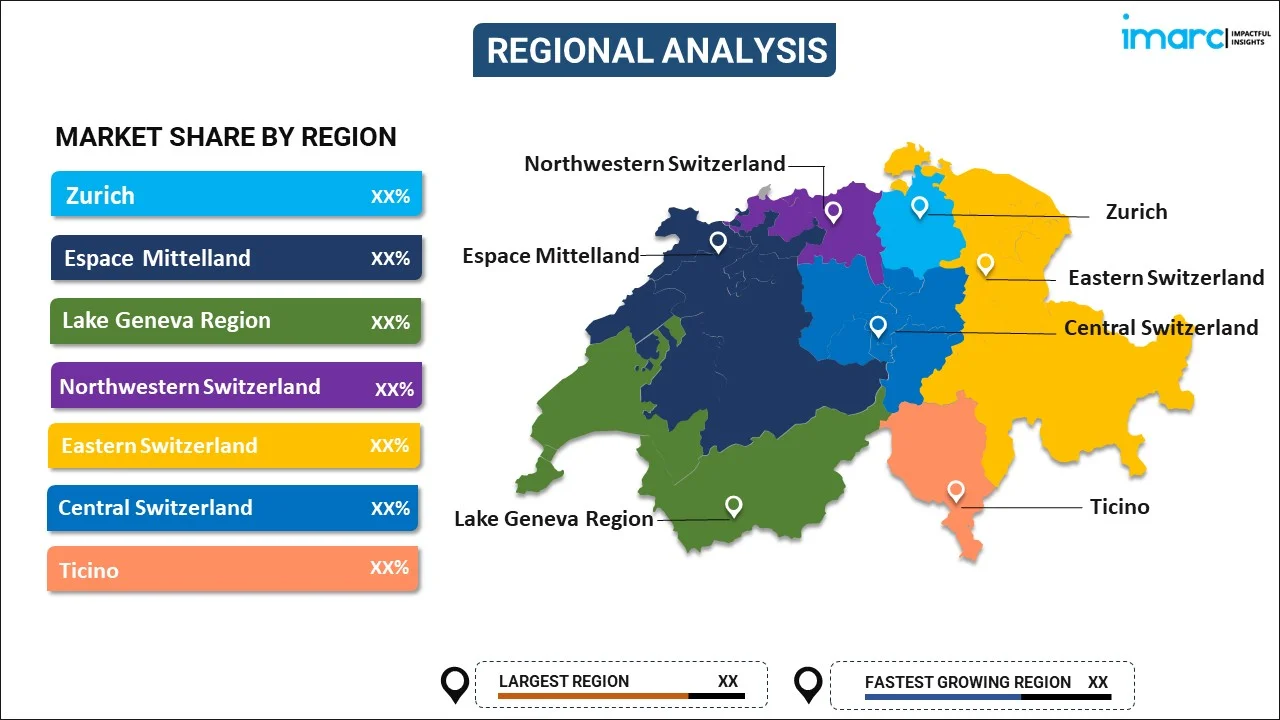
Switzerland Textiles and Apparel Market Report by Material Type (Natural, Synthetic), Application (Clothing Textiles, Technical Textiles, Fashion Textiles, Home-Décor Textiles, and Others), and Region 2025-2033
Switzerland Textiles and Apparel Market Overview:
The Switzerland textiles and apparel market size reached USD 5.6 Billion in 2024. Looking forward, IMARC Group expects the market to reach USD 7.6 Billion by 2033, exhibiting a growth rate (CAGR) of 3.2% during 2025-2033. The market is driven by increasing social media influence through which brands can interact directly with buyers, exhibit their products, and discuss their history, along with the rising number of tourists that benefit local clothing and textile stores.
|
Report Attribute
|
Key Statistics
|
|---|---|
|
Base Year
|
2024
|
|
Forecast Years
|
2025-2033
|
|
Historical Years
|
2019-2024
|
| Market Size in 2024 | USD 5.6 Billion |
| Market Forecast in 2033 | USD 7.6 Billion |
| Market Growth Rate 2025-2033 | 3.2% |
Switzerland Textiles and Apparel Market Trends:
Rising Social Media Influence
According to an article published on the website of the DataReportal, there were 6.92 million social media users in Switzerland at the start of 2024. Global audience reach is made possible for Swiss textile and garment firms by social media platforms. Brands can interact directly with buyers, exhibit their products, and discuss their history and skill. Fashion bloggers and influencers are important players in determining what people want to buy. Influencer marketing is a common strategy used by Swiss firms to promote their goods, which has a direct effect on sales and brand perception. Brands may communicate with people using social media, get feedback, and create devoted fan bases. Strong connections with the audience are facilitated via engaging material, such as interactive postings, customer anecdotes, and behind-the-scenes glimpses. One of the main places to find inspiration and trends in fashion is social media. Similar to customers worldwide, Swiss people follow fashion companies and influencers on social media.
Nowadays, a lot of social media sites include built-in purchasing functions that let users buy things straight from posts or advertisements. The expansion of Swiss clothing and textile brands' online sales is facilitated by this smooth connection. Encouraging clients to post their own images and product reviews on social media contributes to the development of authenticity and trust. The decisions made by prospective customers may be greatly influenced by this user-generated content.
Thriving Tourism Industry
As per an article updated in 2023 on the website of the Federal Statistical Office (FSO), tourism generated around 3% of GDP, accounting for CHF 17 billion in 2021. Travelers go to Switzerland in large numbers, and many of them are interested in buying upscale clothing and textiles as presents or keepsakes. Travelers searching for distinctive, high-end goods are drawn to Switzerland due to its reputation for textile design and craftsmanship. Retail stores see an increase in foot traffic as a result of tourism, particularly in well-known tourist destinations like Lucerne, Geneva, and Zurich. Local clothing and textile stores benefit from the additional foot traffic brought in by these travelers. Products that showcase Switzerland's rich cultural legacy are frequently of appeal to tourists. Visitors' interest in traditional Swiss textiles, like embroidered fabrics and regional costumes, boosts sales and maintains the craftsmanship of the culture. Local textile and clothing manufacturers have fantastic opportunity to sell their products because of the presence of tourists. Hotels, tourist destinations, and events frequently work with regional brands to present their goods to raise awareness and draw in customers.
Travel to Switzerland is very seasonal, peaking in the summer for trekking and winter for skiing. These seasons catalyze demand for particular clothing categories, such as outdoor wear and winter sports equipment, which helps regional textile producers and merchants. When travelers buy Swiss clothing and textiles, they frequently end up representing the company back home. Through word-of-mouth marketing, Swiss brands can reach a wider audience and establish themselves internationally.
Switzerland Textiles and Apparel Market News:
- May 2024: The Confederation of Indian Textile Industry (CITI) and Swiss Textiles joined forces to present a dynamic B2B webinar to enhance Indo-Swiss Textile and Apparel Trade.
- May 2024: Switzerland's Stäubli introduced cutting-edge textile solutions at ITM 2024, including the SAFIR PRO S67.
Switzerland Textiles and Apparel Market Segmentation:
IMARC Group provides an analysis of the key trends in each segment of the market, along with forecasts at the country level for 2025-2033. Our report has categorized the market based on material type and application.
Material Type Insights:

- Natural
- Cotton
- Silk
- Others
- Synthetic
- Nylon
- Polyester
- Others
The report has provided a detailed breakup and analysis of the market based on the material type. This includes natural (cotton, silk, and others) and synthetic (nylon, polyester, and others).
Application Insights:
- Clothing Textiles
- Technical Textiles
- Fashion Textiles
- Home-Décor Textiles
- Others
A detailed breakup and analysis of the market based on the application have also been provided in the report. This includes clothing textiles, technical textiles, fashion textiles, homer-décor textiles, and others.
Regional Insights:

- Zurich
- Espace Mittelland
- Lake Geneva Region
- Northwestern Switzerland
- Eastern Switzerland
- Central Switzerland
- Ticino
The report has also provided a comprehensive analysis of all the major regional markets, which include Zurich, Espace Mittelland, Lake Geneva Region, Northwestern Switzerland, Eastern Switzerland, Central Switzerland, and Ticino.
Competitive Landscape:
The market research report has also provided a comprehensive analysis of the competitive landscape. Competitive analysis such as market structure, key player positioning, top winning strategies, competitive dashboard, and company evaluation quadrant has been covered in the report. Also, detailed profiles of all major companies have been provided.
Switzerland Textiles and Apparel Market Report Coverage:
| Report Features | Details |
|---|---|
| Base Year of the Analysis | 2024 |
| Historical Period | 2019-2024 |
| Forecast Period | 2025-2033 |
| Units | Billion USD |
| Scope of the Report | Exploration of Historical and Forecast Trends, Industry Catalysts and Challenges, Segment-Wise Historical and Predictive Market Assessment:
|
| Material Types Covered |
|
| Applications Covered | Clothing Textiles, Technical Textiles, Fashion Textiles, Homer-Décor Textiles, Others |
| Regions Covered | Zurich, Espace Mittelland, Lake Geneva Region, Northwestern Switzerland, Eastern Switzerland, Central Switzerland, Ticino |
| Customization Scope | 10% Free Customization |
| Post-Sale Analyst Support | 10-12 Weeks |
| Delivery Format | PDF and Excel through Email (We can also provide the editable version of the report in PPT/Word format on special request) |
Key Questions Answered in This Report:
- How has the Switzerland textiles and apparel market performed so far and how will it perform in the coming years?
- What has been the impact of COVID-19 on the Switzerland textiles and apparel market?
- What is the breakup of the Switzerland textiles and apparel market on the basis of material type?
- What is the breakup of the Switzerland textiles and apparel market on the basis of application?
- What are the various stages in the value chain of the Switzerland textiles and apparel market?
- What are the key driving factors and challenges in the Switzerland textiles and apparel?
- What is the structure of the Switzerland textiles and apparel market and who are the key players?
- What is the degree of competition in the Switzerland textiles and apparel market?
Key Benefits for Stakeholders:
- IMARC’s industry report offers a comprehensive quantitative analysis of various market segments, historical and current market trends, market forecasts, and dynamics of the Switzerland textiles and apparel market from 2019-2033.
- The research report provides the latest information on the market drivers, challenges, and opportunities in the Switzerland textiles and apparel market.
- Porter's five forces analysis assist stakeholders in assessing the impact of new entrants, competitive rivalry, supplier power, buyer power, and the threat of substitution. It helps stakeholders to analyze the level of competition within the Switzerland textiles and apparel industry and its attractiveness.
- Competitive landscape allows stakeholders to understand their competitive environment and provides an insight into the current positions of key players in the market.
Need more help?
- Speak to our experienced analysts for insights on the current market scenarios.
- Include additional segments and countries to customize the report as per your requirement.
- Gain an unparalleled competitive advantage in your domain by understanding how to utilize the report and positively impacting your operations and revenue.
- For further assistance, please connect with our analysts.
 Request Customization
Request Customization
 Speak to an Analyst
Speak to an Analyst
 Request Brochure
Request Brochure
 Inquire Before Buying
Inquire Before Buying




.webp)




.webp)












